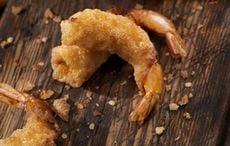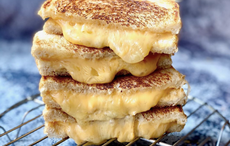Unless you have been on another planet for the past week you will know that the World Cup has begun. This is the first time that it has been held on the African continent and already it is looking to be a great competition apart from those vuvuzelas things that they are blowing on incessantly and sound like a swarm of bees!
Where do I start when I want to describe the cuisine of South Africa? Surely just the fact that South Africa has eleven official languages, as well as many more in everyday usage which haven't attained official status, is enough to establish its broad cultural diversity... South Africa has a tremendously wide cultural heritage, which brings with it different eating habits, different diets, different tastes, different recipes, different cuisines.
South Africa has been referred to as the Rainbow Nation, in part because of its cultural diversity but also in part because of its enormous potential. It is the manifestation of the pot of gold at the end of the rainbow, so to speak.
South African cuisine is part of that rainbow and part of that pot of Gold. {An added bonus is the fact that you can drink the water.}
True South African recipes or cuisine blend together separate ingredients, namely culture and heritage as well as an interesting history, combining them to make a pleasingly tasty whole.
Any discussion regarding South African cuisine has to start somewhere, so let's start at the beginning insofar as it is known...
When the Dutch arrived in the Cape in 1652, they found an area that was extremely sparsely-populated. Some of the people who were already there included the Strandlopers (Beach Walkers), whose recipes would have included boiled and roasted crayfish (Clawless rock lobster), boiled and raw mussels and Abalone. These meats would have been accompanied by roots, fruits and edible seaweed.
Close relatives to the Strandlopers, the Khoi, lived on the coastal plain as semi-nomadic herdsmen. They kept sheep and cattle and one of their favorite recipes, which have survived to this day as a truly original South African recipe, was kaiings; the fat from a sheep's tail fried with wild cabbage.
There were also the San, hunters whose recipes would have included venison, elephant and hippo, together with wild plants, sorrel, mustard leaves, and waterblommetjies (water lilies). The Khoi-San, remnants of these people, live in the Kalahari Desert, still relatively free from the unnecessary trappings of civilization.
The need for food began the colonization of South Africa. The Dutch East India Company needed a re-provisioning station to supply the ships bound for Malaysia with fresh foods after their long trips. Jan van Riebeeck landed in the Cape in 1652 with orders to establish a farm in order to provide fresh vegetables and meat for the ships rounding the Cape.
For labor, the Dutch imported slaves from Sumatra. These slaves became known as Cape Malays and brought their traditions, spices and recipes with them.
In this way, South African cuisine started building up its vast, differentiated library of South African recipes.
Then the French arrived, protestant Huguenot refugees fleeing from persecution. They brought vines with them and transformed forever the agriculture of the Cape. French Recipes blended with Dutch and Cape Malay and became South African recipes. These recipes retained some of the French influence but developed into purely South African Recipes.
All this time, the Xhosa were moving steadily Southwards towards the Cape while the Zulu occupied the area now known as kwaZulu Natal. They were followed by the Sotho, Venda and Tswana. Each people brought with them different tastes and recipes. South African Cuisine was set for the amalgamation of traditional African with dour Dutch, light French and spicy Malay foods, to once again change the face of South African cuisine with new South African recipes.
But Wait! More was yet to be added to the South African Recipe scenario...
In the 1820s, waves of British settlers arrived, bringing with them their "beef and two boiled vegetable" dishes, as well as their puddings.
Later, the British established sugar cane plantations in Natal. Indians were brought to South Africa as indentured servants on ten-year contracts to provide laborers for the plantations. After the contracts were up, the Indians stayed and both Hindu and Muslim people added their individual dishes to the South African Recipe scene.
BOBOTIE
It is known to have been prepared as early as the 17th Century, and the influence of the Dutch East India Company on the colonies of South Africa can be seen in this slightly curried, yet sweet dish.
Although the recipe has a complex medley of textures and flavors, it is fairly simple to make – with most of the cooking process occurring while the dish is in the oven. For this reason, it has been a favorite meal for working mothers and single-parent households where a wholesome meal that is easy to put together is a must. The recipe outlined below will feed approximately 6 people.
INGREDIENTS
Mince
2 Lbs lean ground beef / lamb
2 Medium onions – peeled and chopped finely
1 Tablespoon oil (preferably olive oil)
1 Teaspoon crushed garlic
1 Teaspoon fresh ginger (grated)
1 Tablespoon Chutney
1 Thick slice of stale white bread (or two/three slices of pre-sliced) with the crust removed; and soak in a ½ cup of milk. Remove from the milk, squeeze out the excess, mash with a fork to separate, and set aside
½ Cup Milk
2 Tablespoons lemon juice
½ Tablespoon curry powder (try a medium-strength curry to start off with)
1 Teaspoon turmeric
2 Tablespoons sugar
½ Cup seedless raisins
Salt and ground black pepper to taste
Topping
2 Eggs (medium) beaten
½ Cup milk
Bay leaves (to garnish)
METHOD
Preheat the oven to 325°F
Grease an oven-proof dish
Heat the oil in deep frying pan; add the onions and sauté until clear
Add the garlic, ginger, curry powder and turmeric and mix quickly – don’t leave this on the heat for too long, as the garlic can burn
Add the ground beef / lamb and keep stirring on medium heat until browned
Add the sugar, mashed bread, chutney, lemon juice and raisins to the mixture
Season to taste with salt and pepper
Spoon the mixture into the greased dish, and place into the oven for 35 minutes.
Mix the eggs with ½ a cup of milk, and any milk that may remain from the bread
Remove the dish from the oven, and spread the egg mixture evenly over the top
Add the bay leaves as decoration, and put back into the oven for approximately 15-20 minutes, or until the topping has set
To serve Bobotie
Although South African winters are fairly mild, Bobotie is generally served with rice as comfort food in winter. The rice is generally cooked to be yellow in color (by adding a small amount of turmeric to it); and chutney and sliced bananas are often served as accompaniments. Alternatively, the Bobotie and rice can be served with a small side salad of tomatoes, cucumber and lettuce with a vinaigrette dressing.
AND FINALLY…
President Mandela goes on an official state visit to a small country in the middle of Africa. At the airport he is met by this country's Minister of Harbors.
All of a sudden Mr. Mandela realizes that this is absurd, this country has no harbours as it is landlocked! He is very puzzled and decides to find out what the story is.
At the official state banquet later that evening, he leans over to the President and asks, "Mr. President, why do you have a Minister of Harbours when you don't have any harbours?"
The President looks Mr. Mandela straight in the eye and says, "Well you know that may be true Mr. Mandela, but I was just as puzzled at why you have a Minister of Law and Order?"




Comments